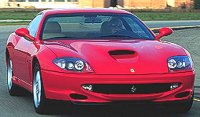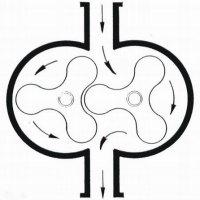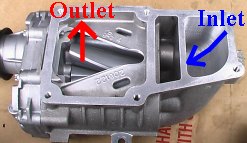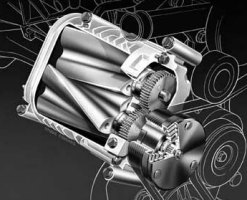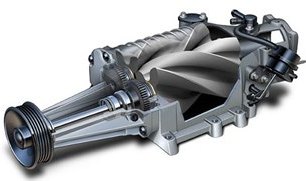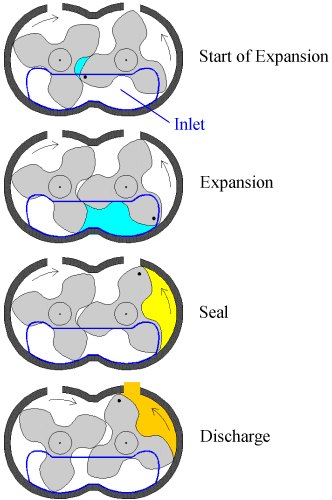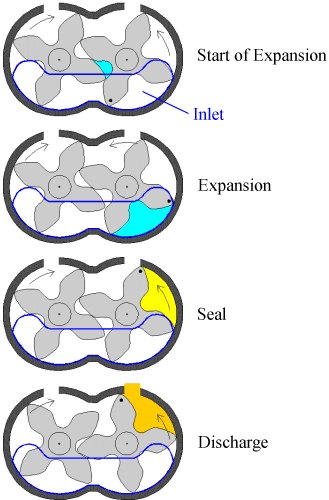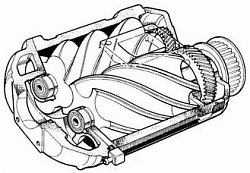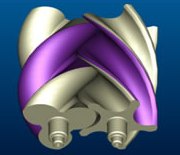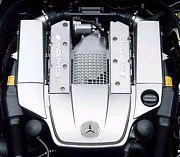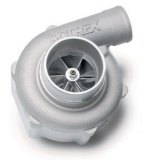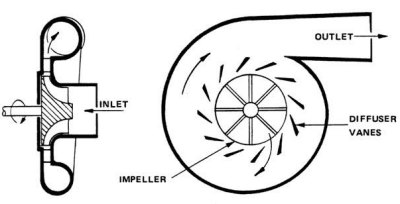|
AUTOZINE TECHNICAL SCHOOL
Forced Induction Ram Air Intake
Ram air intake is perhaps the simplest kind of forced induction. When the car is travelling at speed, air will be forced into the intake manifold through the ram air inlet which usually locates at the top of bonnet. This generates a slightly higher pressure than normal aspiration. The higher intake pressure not only accelerates engine breathing but also leads to a slightly denser air filling the combustion chambers, very much like a light supercharging. Of course, the latter helps generating more power.
Ram air intakes can be easily seen in motor racing. The air box on every Formula race car and the roof-mounted air intakes on many GT or endurance race cars are ram air devices. A Formula One engineer said a typical air box can contribute to an additional 20 horsepower at 200 km/h (124 mph). It's not a big gain, but it's free, with almost no drawbacks. At low speed, however, the effect of ram air is negligible.
Supercharging Before turbocharging arrived in the 1960s, supercharging had been dominating the forced induction world. Supercharging, also called mechanical charging, appeared in the early 1920s in Grand Prix cars as a means to boost power without enlarging engines. Since the compressor is driven directly by the crankshaft, it has the advantage of instant response compare with turbocharging. On the downside, the charger itself is rather heavy and energy inefficient, thus it cannot produce as much power as turbocharger. Especially at high rev, it generates a lot of friction hence energy loss and prevent the engine from revving higher. A typical supercharger transforms the output characteristic very much - it flattens the torque curve and shifts its peak towards the lower end of spectrum. Consequently, power becomes much easier to access. On the flip side, the engine becomes less enthusiastic for rev. A lower redline and declining high-rev output means the supercharged engine does not encourage the driver to work harder at throttle or gearchange. For these reasons, supercharging is quite well suited to nowadays heavy sedans, espeically those mated with automatic transmission. On the other hand, sports cars find little merits to use it. The noise, friction and vibration generated by mechanical supercharger are the main reasons preventing it from being used in luxury cars. Although Mercedes-Benz did introduce a couple of supercharged fours (dubbed "Kompressor") into its C-class, it had never tried the same idea on larger models. In 2010, the Kompressor engines on C-class were replaced with turbocharged ones, ending the company's mass use of superchargers. The advancement of other technologies, such as variable valve timing, direct-injection, light-pressure turbos and advanced turbo diesel, also threatened the very existence of supercharging. Volkswagen dropped its G-Ladder supercharger in the mid-1990s in favour of light-pressure turbo. General Motors used to produce the most supercharging engines thanks to its supercharged 3800 V6. Following the retirement of that engine in the late 2000s, its usage of supercharging is limited to the small batches of high-performance Cadillac CTS-V and Corvette ZR1. Roots type supercharger
Eaton TVS supercharger
Compare with the previous generation (Gen 5) Eaton superchargers, the TVS has many advantages. First of all, it can provide 20 percent higher air flow, hence higher boost and power; Secondly, it consumes less power at high rev. For example, the one on Corvette ZR1 consumes 75 horsepower at peak power, versus 115 hp on the Gen 5. This translates to higher efficiency, of course. Thirdly, it generates less heat thus depends less on intercooling. Lastly but not least, it largely eliminates the ugly noise traditionally associated with Roots-type superchargers. From mechanical point of view, the TVS has two significant changes from conventional Roots type superchargers: 1) Its rotors have 4 lobes instead of 3 lobes; 2) The twist angle of its rotors is increased from 60 degrees (on Gen 5) to 160 degrees. Let's see how these changes affect its performance. The TVS produces higher air flow because the 4-lobe rotors enable larger total volume than the old 3-lobe rotors. It's only simple geometry. Regarding accoustic quality, by doubling the tooth of drive gears, mechanical noise is lifted to higher frequency range which is less annoying to human ears. Besides, better internal air flow management reduces air noise. Regarding higher efficiency, it is contributed by two factors. The first is the larger air inlet on TVS. The illustrations below show a comparison between conventional Roots supercharger and TVS on how they go through one cycle of operation. The cycle consists of 3 phases - Expansion, Seal and Discharge. It is the Seal phase that dictates the size of air inlet. The illustration shows that the TVS can use considerably larger air inlet because its 4-lobe design reduces the span of Seal phase to 90 degrees (vs 120 degrees on the 3-lobe design). This allows the inlet to open wider. If the conventional supercharger used the same large inlet as TVS, the Seal would never happen, and the chamber would bridge between the inlet and outlet thus release all the high pressure at the outlet side.
So what is the benefit of a larger inlet? The most obvious is less restriction on the rate of air flow. But we are now talking about efficiency rather than the amount of air flow, so there must be another reason... actually a very complicated reason. It takes some more explaination... To understand how it improved efficiency, perhaps we should study how a conventional Roots supercharger waste energy first. As I have mentioned, part of the energy is wasted through mechanical friction. (TVS reduces that loss by using tighter machining rotors and friction-reducing coating.) However, an even higher percentage of energy loss is due to the internal flow of the supercharger. Let's look back to the illustration above. At the start of expansion phase, you can see a new space is created between the rotors (the blue area). This space enlarges quickly (the second picture) and sucks air from the inlet to fill that space. In fact, the rotor is spinning so fast (up to 20,000 rpm) that this space enlarges at enormous speed. As a result, the part vacuum created is also enormous and the air rushes into this space at very high velocity. You can imagine what happens when this high-speed air flow hits the end of the space - it finds no way to go, then compresses, bounces back, hits the incoming air following it and causes great turbulences. Such rapid change of velocity and pressure transforms the kinetic energy to heat. In fact, Roots-type superchargers waste a lot of energy in the form of heat. It takes charge cooler and intercooler to lower the temperature, but then wasted is wasted. Now, the TVS has a considerably larger inlet. This mean the air flow goes through the inlet will be slower. Slower air flow means less kinetic energy, hence less energy is transformed to heat. Another factor contributing to its improved efficiency is the larger twist angle of rotors. With 160º twist angle, in Expansion phase the rotor takes 160º of rotation to realize full volume of chamber (blue area in picture). This mean the rate of expansion is much slower than the case of 60º twist angle, where full volume is realized with just 60º of rotation. Slower expansion reduces the part vacuum thus lowers further the velocity of intake air flow. Consequently, the aforementioned waste of kinetic energy is also reduced.
Lysholm (screw type) supercharger
Lysholm is also called screw type supercharger. Although its theory was invented as early as 1878, it was not until 1930s that Alf Lysholm improved and realized the idea. The supercharger consists of 2 screws, one with male threads and another with female threads. They closely mesh together. When they rotate, air is captured between the screws and the housing while being pushed from the inlet towards the outlet. Moreover, the space gets smaller and smaller as it moves forward, so Lysholm performs internal compression and enables higher boost pressure than Roots type supercharger. Apart from high boost pressure, Lysholm supercharger has advantages of high efficiency, wide rpm range and compact size, so it is the first choice for performance cars. On the downside, it is very expensive to build, because the tightly meshed nature of the screws means they need very high precision machining.
Centrifugal supercharger
|
||||||||||||||||||||||||||||||||||||||||||||||||||

|
||||||||||||||||||||||||||||||||||||||||||||||||||
| Copyright© 1997-2011 by Mark Wan @ AutoZine |
